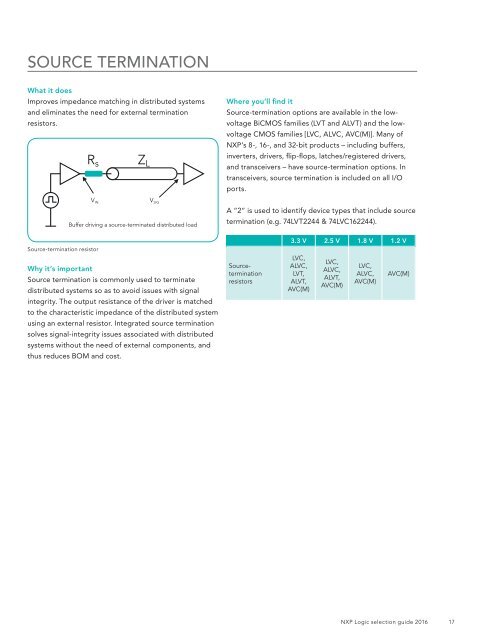Logic selection guide 2016
1Sk34oD
1Sk34oD
Create successful ePaper yourself
Turn your PDF publications into a flip-book with our unique Google optimized e-Paper software.
SOURCE TERMINATION<br />
What it does<br />
Improves impedance matching in distributed systems<br />
and eliminates the need for external termination<br />
resistors.<br />
R s Z L<br />
V IN<br />
V SIG<br />
Buffer driving a source-terminated distributed load<br />
Where you’ll find it<br />
Source-termination options are available in the lowvoltage<br />
BiCMOS families (LVT and ALVT) and the lowvoltage<br />
CMOS families [LVC, ALVC, AVC(M)]. Many of<br />
NXP’s 8-, 16-, and 32-bit products – including buffers,<br />
inverters, drivers, flip-flops, latches/registered drivers,<br />
and transceivers – have source-termination options. In<br />
transceivers, source termination is included on all I/O<br />
ports.<br />
A “2” is used to identify device types that include source<br />
termination (e.g. 74LVT2244 & 74LVC162244).<br />
Source-termination resistor<br />
Why it’s important<br />
Source termination is commonly used to terminate<br />
distributed systems so as to avoid issues with signal<br />
integrity. The output resistance of the driver is matched<br />
to the characteristic impedance of the distributed system<br />
using an external resistor. Integrated source termination<br />
solves signal-integrity issues associated with distributed<br />
systems without the need of external components, and<br />
thus reduces BOM and cost.<br />
Sourcetermination<br />
resistors<br />
3.3 V 2.5 V 1.8 V 1.2 V<br />
LVC,<br />
ALVC,<br />
LVT,<br />
ALVT,<br />
AVC(M)<br />
LVC,<br />
ALVC,<br />
ALVT,<br />
AVC(M)<br />
LVC,<br />
ALVC,<br />
AVC(M)<br />
AVC(M)<br />
NXP <strong>Logic</strong> <strong>selection</strong> <strong>guide</strong> <strong>2016</strong><br />
17


